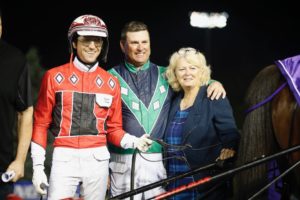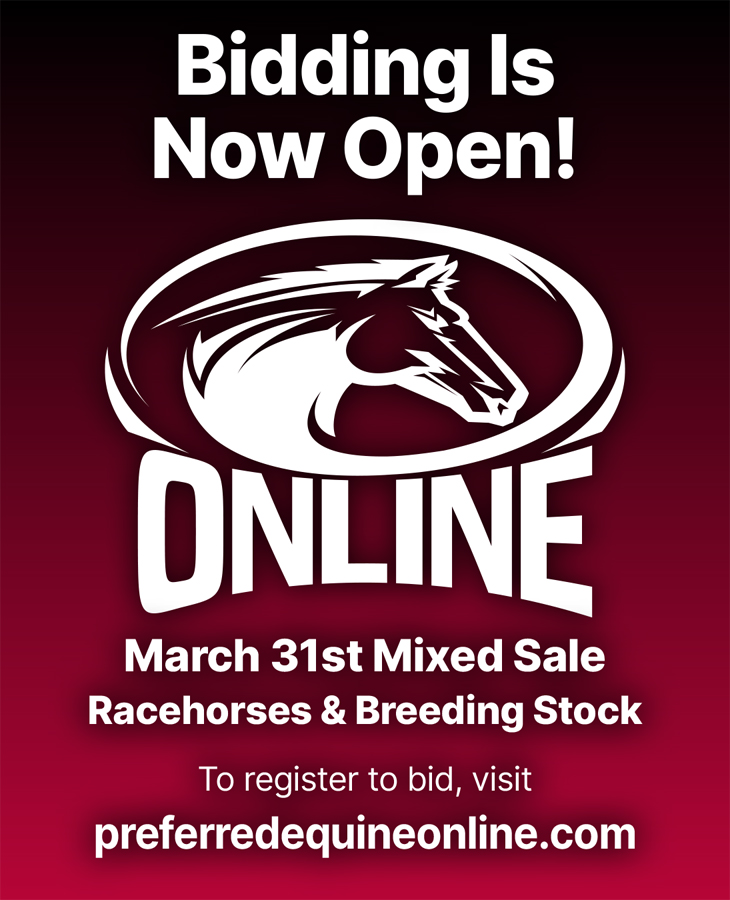The incredible, indispensable Donna Lee
Tony Alagna’s mother is essential to his operation.
by Murray Brown
Is there a more unique situation in horsedom than that which Tony Alagna shares with his mom Donna Lee? One would be inclined to think not. Alagna’s rise in harness racing has been nothing less than meteoric, although it has taken more time than this scribe initially thought.
In October of 2009, Alagna, then working with Erv Miller, decided that it was time to spread his wings and fly on his own. He started with about a dozen horses under his care. The training empire under his control now extends to between 100 and 120 horses.
Alagna’s mom, Donna Lee, had been struggling In Illinois’ faltering harness racing industry until she decided to make a break and join her son’s team.
“I had done all the bookkeeping from the time that he started,” Lee said. “He said, ‘Don’t worry mom, I’ll never have more than 30 head.’”
At that time, Alagna had approximately 20 horses under his care.
“I was definitely the employee, not the employer. It used to be the opposite. Nevertheless, I felt that Tony needed me and that I hopefully could be of help to him and his operation. I feel that the arrangement has worked out well for both of us.
“At that time, there was no defined role for me in the operation. I feel that I helped where help was needed in just about every phase of the operation. Did Tony need a rider? I was available. Did he need someone to take charge of the bookkeeping? I was there. Could I help with client relationships? I was available.”
A unique situation developed in 2015. Tony had several Canadian owners as well as Ontario-bred horses in the stable. He asked if Donna Lee would take a draft of horses to Canada and set up camp there during the warm weather part of the racing season. Why not? When Donna Lee and the author spoke, she had 15 head under her care. She anticipated that the number would rise to close to 30 once the Grand Circuit racing began.
Q: How do you manage with the ebb and flow associated with having changing numbers of horses under your care? Next week you will likely have twice as many here as you do today.
“We cope as it becomes necessary. The biggest problem is in securing and retaining enough good help. That isn’t a problem unique to us. It’s pervasive throughout the business. We pay well in Canada — $150 per horse and $150 paddocks. However, being a caretaker isn’t the easiest job in the world. The most difficult part of it are the hours, more specifically the need to work seven day weeks and often going without a break from the grind.”
Q: How often do you speak with your son?
“Every single day. More often than not as many as four or five different times a day. I have to say, though, that my son, at the fear of giving him a swelled head, is an extremely unique person. He personifies the term workaholic. He is on top of everything that is happening whether it be with the horses, the staff, the owners and sometimes even with me. He has a photographic memory. You don’t have to tell him anything more than once. Once it enters that mind of his, it is there forever. He knows every horse of his as well as a good many from elsewhere on sight. Not only does he know them, but he also knows the equipment they wear and their likes and dislikes. He doesn’t miss anything. I don’t know how he manages to do everything that he does. in addition to all the horse-related areas, he is also a great people person. It seems he is always available to speak with the numerous owners in the stable.”
Q: How many owners do you have in the stable?
“Right now the number is 64. It might range from a person who has a small percentage of one horse to an individual who has interests in as many as 20 or even more.”
Q: Have you developed relationships with any of the owners in the stable?
“Tony speaks with the owners far more than I do. I’m fairly close with and speak to Al Saul of the Big Al’s Stable quite a bit. I’m guessing that part of it is that he is a Canadian and lives here. He enjoys being with and around his horses. We speak often. Another owner in the stable with whom I’ve become friends with is Dr Richard Gordon. ‘Gordo’ as he is sometimes called owns small parts of two horses in the stable, but he is as enthusiastic about harness racing as just about anybody as I’ve ever known. The strange part of our relationship is that I speak with him and a few other horse people often and regard him as a friend, but we’ve never actually met. I had some serious health issues this last year. Dr. Gordon was invaluable in furnishing information and lending support. Other owners with whom I’ve become friendly are John Fodera, Steve Wienick, Sam Bowie and of course Myron.”
Q: Can you expound on the health issues?
“One word cancer. I was diagnosed with it this past winter. I was operated on and had the upper lobe of my left lung removed on March 8. That took place after nine and a half weeks of chemo and radiation while in Florida. Tony, the great son that he is, came down to take care of me. I told him at the time that I’d be back and riding within 30 days. I guess I lied. I was back in the office in 10 days and back in the bike in 31 days.
Q: Let’s talk some about the horses. Who is your favorite?
“That would undoubtedly be Caprice Hill. I had her from the time she was a yearling until she retired from racing. She was sweet, highly intelligent and really loved to race. If any of the other horses in the stable was scheduled to race when she wasn’t, she would carry on to no end. She wanted her share of the action. Another of my favorites is Dr J Hanover. When he was done racing, he was given to me as a riding horse. He is part of my menagerie which includes one other horse retiree and my faithful dog Freckles. Freckles and Dr J have something in common. They are both fat and lazy.”
Q: What about your team? How many people do you have working with you?
“It can vary from week to week. It is always subject to change. Many of our caretakers are of Hispanic background and have been with us for some time. Tony has a big edge in that area. He is quite fluent in Spanish and is able to converse well with them. Another indispensable associate of ours is Hall of Famer Cat Manzi who has now been with us for four years. We added another great component this past season when Jan Johnson, a man with Hall of Fame credentials joined the team. He stayed in Florida with me overseeing the horses we had down there this past winter.”
Q: How did that work out for you? This was the first time that Tony had his stable split into two segments.
“I thought it worked out just fine. It was a bit of an adjustment, though. Jan and I were in charge in Florida. Tony would come down every two weeks. It worked smoothly. Playing results, it appears that we are having a banner year with our 2-year-olds. We split the babies and the 3-year-olds evenly between Florida and New Jersey.”
Q: That brings up the question of what you guys will be doing this coming season. Will you do what you did last year and maintain a two-pronged presence or will you stay up north with all the horses?
“Tony hasn’t yet decided. Of course the final decision will be up to him. If it were up to Jan and me, and I suppose a group of the owners, we would do what we did last year. We’d still keep the Florida operation going. It would probably be cheaper and maybe more efficient if everything remained at Tony’s training center in New Jersey. Jan lives in Florida. I’m sure he’d be reluctant to leave. I own a condo in Florida. I suppose I could sell it, but I’ve grown used to the kind Florida weather. I’m not getting any younger or any less resistant to change. However I’ve got some Gypsy in me, I like to move around. Many of our owners have winter homes in Florida. They enjoy coming out to the training center and seeing their future champions train. Ultimately it’s up to my son.”
Q: You’ve been coming up to Canada now for eight years. How do you like it?
“I like it a lot. I especially like the people. I find that, generally speaking, they are kind, friendly and helpful. The weather at this time of year is just fine. None of the tracks are too far from each other. I don’t need to worry too much about shipping great distances. There are numerous excellent horsemen around. I’ve grown to really admire Ben Baillargeon and Luc Blais. There is a great community of people.”
Q: Is there anything you don’t particularly like?
“I suppose if I would be picking just one thing, it would probably be the restaurants. There are undoubtedly some real good ones, but unfortunately I haven’t found many of them.”
Q: Who do you use to drive for you?
“When he’s available my first choice is Doug McNair. First of all, he is an excellent driver. I find that he takes good care of a horse. Our owners really like him and that is very important.”
Q: In your opinion is there anything that distinguishes the Alagna stable from most others?
“We are very detail oriented. There is nothing too small for Tony not to be involved with. Another thing is that we train our horses in large groups. When our horses hit the racetrack, they are, in effect, ready to race, because there are no surprises. They know what it’s all about. They’ve already done it.”
Have a question or comment for
The Curmudgeon? Reach him by email at: hofmurray@aol.com

















